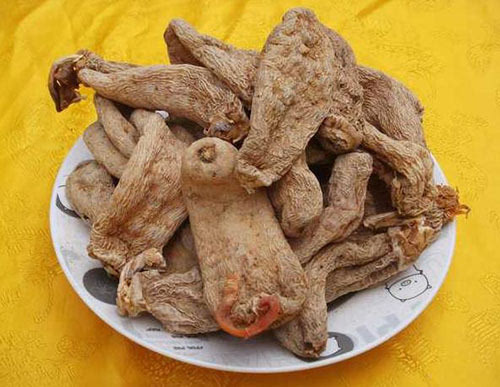As the name implies, the medicinal part of poke root, also known as Shang Lu in Pinyin, is its root. The medicinal uses of pokeroot has a long history in Chinese herbal medicine and dates back as far back as 2,000 years ago since it has been listed in the "Shen Nong's Herbal Classic". And Ben Cao Gang Mu (The Compendium of Materia Medica) also comments that it has a descending medicinal properties that makes it resemble Jing Da Ji (Euphorbia pekinensis) and Gan Sui (Euphorbia Kansui), which are an expert of controlling water metabolism. So, what is poke root good for today? Clinically it is still widely used in the treatment of mastitis (breast infection), Breast Cancer, lymph, thyroid, boils, scabies, Edema, hot sores, lung disorders, swellings, fibroids, arthritis, clogged ducts, breast lumps, poison ivy, and so on.
Medicinally it mainly refers to the dried root of Phytolacca acinosa Roxb. or Phytolacca americana L., which are two members of Pokeweed family (Phytolaccaceae). Hence, other common names of this herb include common pokeweed, red ink plant, Virginia poke, poke salad, American nightshade, poke sallet, cancer jalap, poke berry or pokeberry, coakum, poke, garget, inkberry, pocan, cancer root, pokeweed, pigeon berry, Radix Phytolaccae, redweed, Phytolacca acinosa root, scoke, Chui Xu Shang Lu, and more. It is produced in most parts of China, in particular in Henan, Anhui, and Hubei provinces. It is harvested from autumn to following spring, sliced, dried in the sun or in the shade, and used raw or rice-vinegar processed medicinally.

Poke Root
POKE ROOT BENEFITS
As a traditionally used Chinese herb, it is categorized as a drastically purgating water drug and commonly used in the treatment of all kinds of excess edema. Pharmacological studies suggest that pokeroot has an amazing therapeutic effect for many diseases, such as glomerular sclerosis, nephrotic syndrome, diabetic nephropathy, and other secondary kidney damage due to immune system disorders. And modern pharmacology believes that its main chemical constituent of esculentoside can reduce inflammation, induce γ-interferon, enhance leukocyte phagocytosis, promote DNA transformation, prevent impregnation, and kill soncomelania. As a matter of fact, it can do more as follows.
POKE ROOT RECIPES ON HERBAL REMEDIES
The Chinese Materia Medica thinks that it is bitter in flavor and cold and toxic in nature. It goes to meridians of spleen, bladder, and small intestine. Main functions are relieving edema through diuresis, increasing urinary and stool output, resolving toxin and dissipating binds. Basic poke root uses and indications include puffiness caused by edema, difficult urination and bowel movement, abdominal mass, abdominal mass in left or right hypochondrium, scrofula, and carbuncle. Recommended poke root dosage is from 3 to 10 grams in decoction. Besides, there are many other pokeroot forms available too, such as poke root tea, extract, tincture, essential oil, salve, cream, infused oil, juice, ointment, lotion, powder, and more.
1) Shang Lu Dou Fang from Sheng Ji Zong Lu (Complete Record of Holy Benevolence). It is coupled with Chi Xiao Dou (Adzuki Beans) and carp to treat edema accompanied with breathing rapidly and shortness of breath.
2) Shang Lu San from Yang Shi Jia Cang Fang (Yang Family Depository of Formulas). It is combined with Euphorbia Kansui powder and mole cricket to cure ten types of Edema.
3) Shu Zuo Yin Zi from Ji Sheng Fang (Life-saving prescriptions). It is formulated with Ze Xie (Water Plantain), Adzuki Beans, Qiang Huo (Notopterygium), Da Fu Pi (Areca Peel), Jiao Mu (Zanthoxyli Semen), etc. to heal edema that is characterized as whole body swelling, dyspnea and tachypnea, irritation and thirst, and difficult bowel movement and urination.

![Diseases, Symptoms, tcm, [tcmwindow.com]](/uploadFile/adImg/2015/11/11/f5cbfcc0-4df5-4646-9b9a-f316651a0199.jpg)





